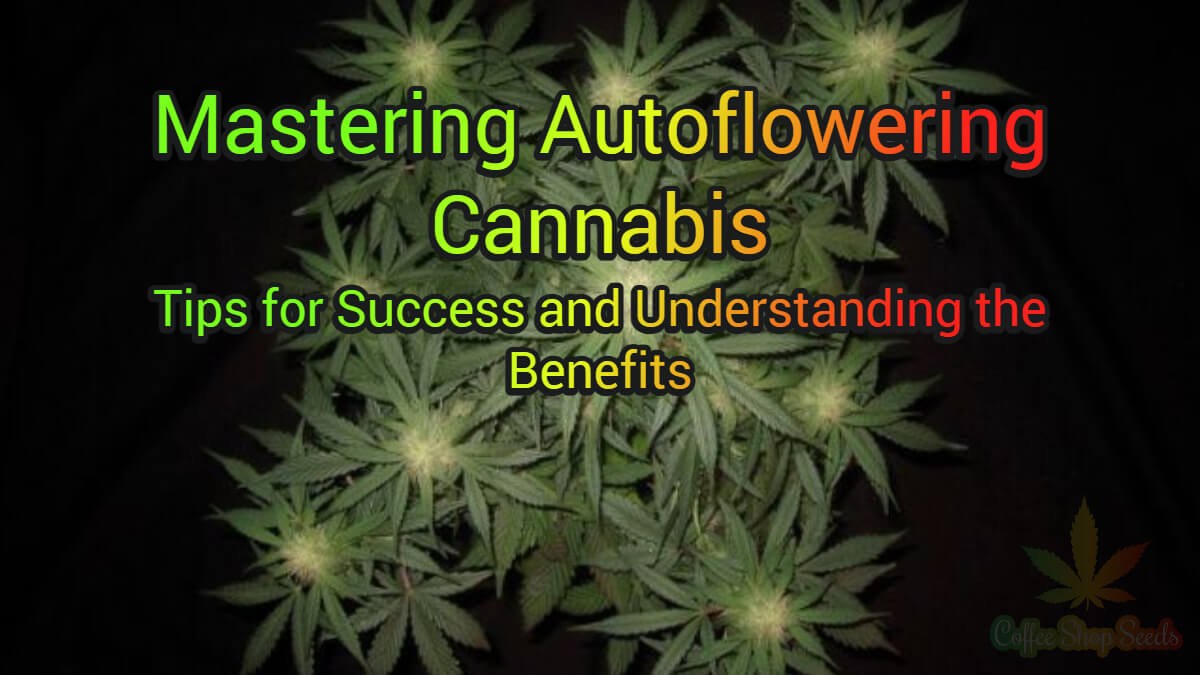Introduction:
The world of cannabis cultivation is vast and filled with potential, offering opportunities to grow plants in myriad ways, each boasting unique advantages. For those just embarking on their cultivation journey or even seasoned growers seeking a more efficient and convenient option, autoflowering cannabis plants are an excellent choice. Welcome to the versatile universe of autoflowering cannabis, where a harmonious blend of convenience, resilience, and quality come together to create a rewarding and enjoyable growing experience.
Autoflowering cannabis plants are the result of careful breeding, combining the genetics of Cannabis ruderalis – a hardy, resilient species native to colder climates – with those of Cannabis sativa or Cannabis indica. The defining trait of autoflowering plants is their ability to transition from the vegetative stage to the flowering stage automatically, without relying on photoperiod or light cycle changes as their non-autoflowering counterparts do. This unique feature offers several advantages, including shorter cultivation times, compact plant size, and adaptability to a variety of growing conditions.
One of the key benefits of autoflowering cannabis is the speed at which they reach maturity, which can be particularly advantageous for novice growers or those seeking a faster harvest. While photoperiod plants may take several months from seed to harvest, most autoflowering strains complete their life cycle in as little as 7 to 10 weeks. Additionally, their compact size makes them well-suited for indoor cultivation or discreet outdoor growing, catering to various space constraints and preferences.
In this comprehensive guide, we aim to provide essential knowledge for successfully cultivating autoflowering cannabis plants, sharing tips for maximising your harvest and enjoying the unique benefits these strains offer. From selecting your ideal strain and understanding the growing process, to troubleshooting common issues and fine-tuning your techniques, our goal is to equip you with the tools and knowledge required to fully appreciate the potential of autoflowering cannabis plants.
Selecting Your Autoflowering Seeds: Strain Selection Tips
As with any cannabis cultivation venture, selecting the right strain is a crucial first step. With countless autoflowering seeds available, you’ll want to consider factors such as desired plant size, aroma, potency, and effects. As the market for autoflowering cannabis expands, a broader range of strains featuring diverse cannabinoid and terpene profiles, as well as varying growth habits, has become available. Explore various options and consider what resonates with your unique preferences and growing constraints.
Preparing for Your Grow: Indoor vs. Outdoor Cultivation
While autoflowering cannabis plants are adaptable to various growing conditions, choosing between indoor and outdoor cultivation depends on your specific situation and goals as a cultivator. Both options have their pros and cons, ultimately contributing to the overall success and quality of your harvest.
*Indoor Cultivation*
The primary advantage of cultivating autoflowering cannabis indoors is greater control over environmental conditions, including light, temperature, and humidity. Consistent monitoring and fine-tuning of these parameters can lead to a higher-quality harvest, and the compact size of autoflowering plants makes them well-suited for limited indoor spaces. Additionally, indoor cultivation allows for multiple harvests per year, as plants are not reliant on the seasons.
*Outdoor Cultivation*
For those who prefer a more natural approach, growing autoflowering cannabis outdoors is an excellent choice. Outdoor cultivation offers cost savings as sunlight is utilised rather than artificial lighting. Furthermore, autoflowering plants can be grown discreetly outdoors due to their small size and short life cycle. Though outdoor plants may be more susceptible to pests and environmental stressors, they still offer remarkable resilience and adaptability.
Cultivating Autoflowering Cannabis: Essential Tips for Success
With your seeds selected and your preferred cultivation method chosen, it’s time to jump into the growing process. Whether you’re an experienced cultivator or completely new to cannabis cultivation, these essential tips will help ensure your autoflowering plants thrive.
1. Gentle Transplanting: Due to their rapid life cycle, autoflowering plants have less time to recover from transplant-related stress. To minimise this stress, use a gentle hand when transplanting seedlings, or consider planting seeds directly into their final container.
2. Optimal Lighting: Autoflowering cannabis plants typically require more light than photoperiod plants. Aim for 18-24 hours of light during the vegetative stage and at least 12-18 hours during the flowering stage to ensure optimal growth and development.
3. Nutrient Considerations: Autoflowering plants require a slightly different nutrient balance compared to photoperiod plants. During the vegetative stage, focus on providing higher levels of nitrogen, transitioning to higher levels of phosphorus and potassium during the flowering stage. Additionally, ensure your plants receive essential micronutrients such as calcium and magnesium.
4. Low-Stress Training (LST): While traditional high-stress training (HST) techniques like topping and pruning may be too invasive for autoflowering plants, LST methods can enhance growth and yield without causing undue stress. Techniques like bending, tying, and securing branches gently encourage horizontal growth and even light distribution, leading to better overall plant health and more substantial yields.
Troubleshooting Common Autoflowering Cannabis Issues
As with any horticultural pursuit, growing autoflowering cannabis can present various challenges and issues along the way. Addressing these issues proactively and effectively is integral to the success of your harvest.
1. Slow Growth or Low Yields: Inadequate lighting, insufficient nutrients, or improper environmental conditions can hinder your plants’ growth and lead to disappointing yields. Troubleshoot these issues by adjusting light levels, providing appropriate nutrients, and maintaining optimal temperature and humidity conditions.
2. Pests and Diseases: While autoflowering plants are generally resilient, they can still fall prey to pests and diseases. Preventing these issues begins with maintaining a clean and sterile grow space, implementing pest control measures, and regularly monitoring your plants for signs of trouble.
3. Herma\-phroditism or “Herming”: Autoflowering cannabis plants may develop both male and female reproductive organs – a phenomenon known as herming. This typically occurs when plants are subjected to extreme stress or poor growing conditions. If detected early, you can separate hermaphrodite plants from the rest of your crop to prevent unwanted pollination.
Reaping the Rewards: Harvesting Your Autoflowering Cannabis
You’ve cultivated your autoflowering cannabis plants with dedication and care, and the moment has finally arrived: it’s time to harvest and enjoy the fruits of your labour. Before harvesting, pay close attention to the trichomes – the tiny, sticky, resin-producing glands on the flower. When the majority of trichomes have transitioned from a clear to a milky-white or amber colour, your plants are ready for harvest.
By following these cultivation tips and troubleshooting common issues, you will maximise your chances of a successful autoflowering cannabis grow, yielding a diverse and bountiful harvest that showcases the unique advantages of these plants.
Enjoy the satisfying rewards of cultivating autoflowering cannabis with expert guidance and support throughout your journey. Whether you’re a novice grower or a seasoned cultivator, let’s explore the world of autoflowering wonders together and revel in the unparalleled convenience, versatility, and resilience of these remarkable plants. Get your cannabis seeds here.


